The AMD Radeon R9 290 Review
by Ryan Smith on November 5, 2013 12:01 AM EST- Posted in
- GPUs
- AMD
- Radeon
- Hawaii
- Radeon 200
Overclocking
Finally, let’s spend a bit of time looking at the overclocking prospects for the 290. Without any voltage adjustment capabilities and with AMD binning chips for clockspeeds and power consumption we’re not necessarily expecting a lot of headroom here, but none the less it’s worth checking out to see how much more we can squeeze out of the card.
Even though we’re officially limited to AMD’s Overdrive utility for the moment for overclocking, Overdrive offers a wide enough range of values that we shouldn’t have any problem maxing out the card. In fact we’ll be limited by the card first.
| Radeon R9 290 Overclocking | |||
| Reference Radeon R9 290 | |||
| Shipping Core Clock | 662MHz | ||
| Shipping Boost Clock | 947MHz | ||
| Shipping Memory Clock | 5GHz | ||
| Shipping Boost Voltage | ~1.18v | ||
| Overclock Core Clock | 790MHz | ||
| Overclock Boost Clock | 1075MHz | ||
| Overclock Memory Clock | 5.6GHz | ||
| Overclock Max Boost Voltage | ~1.18v | ||
Despite the lack of voltage control, when it comes to overclocking the 290 we were able to achieve solid overclocks on both the GPU and the memory. On a boost clock basis we were able to push the 290 from 947MHz to 1075MHz, an increase of 128MHz (14%). Meanwhile we were able to push the memory from 5GHz to 5.6GHz before artifacting set in, representing a 600MHz (12%) memory overclock. Being able to increase both clockspeeds to such a similar degree means that no matter what the video bottleneck is – be it GPU or memory – we should see some kind of performance increase out of overclocking.
On a side note, for overclocking the 290 we stuck with moderate increases to both the maximum fan speed and the PowerTune limit. In the case of the former we used a 65% maximum fan speed (which actually proved to be more than what’s necessary), while for the latter we went with a 20% increase in the PowerTune limit, as at this point in time we don’t have a good idea for what the safe power limits are for the reference 290/290X board. Though in either case only FurMark could push the overclocked card to its power limit, and nothing could push the card to its fan speed limit. Similarly we didn’t encounter any throttling issues with our overclocked settings, with every game (including CoH2) running at 1075MHz sustained.
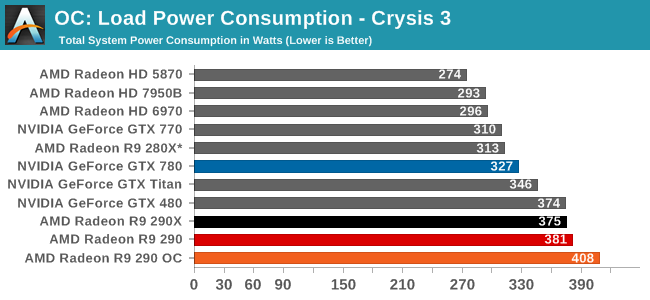
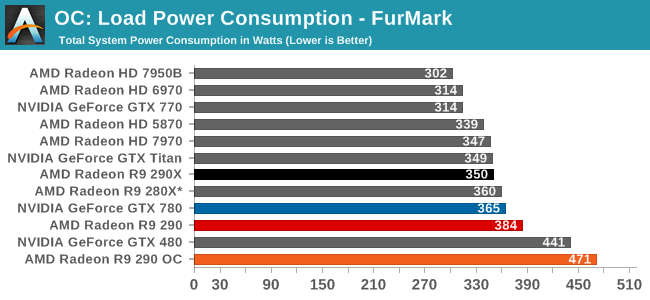
Taking a brief look at power, temp, and noise before jumping into our gaming performance results, we can see that overclocking the card has a measurable impact on power consumption under both Crysis 3 and FurMark. With Crysis 3 we’re clockspeed limited before we’re power limited, leading to an increase in power consumption of 27W, while under FurMark where we were power limited it’s a much more academic increase of 87W.
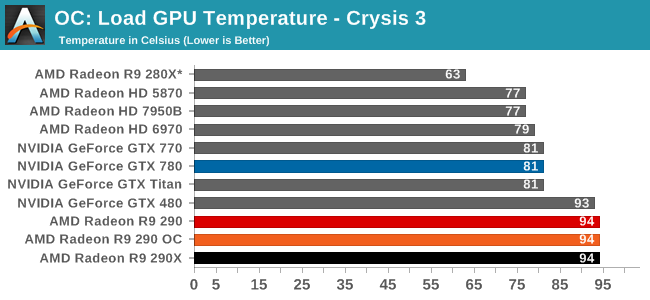
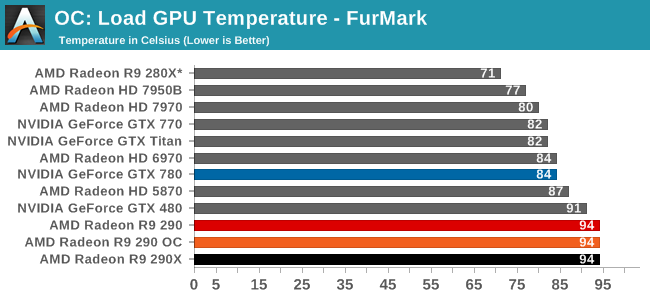
Since the 290 already ships at the highest temperate limit it allows – 95C – our sustained temperatures are unchanged even after overclocking.
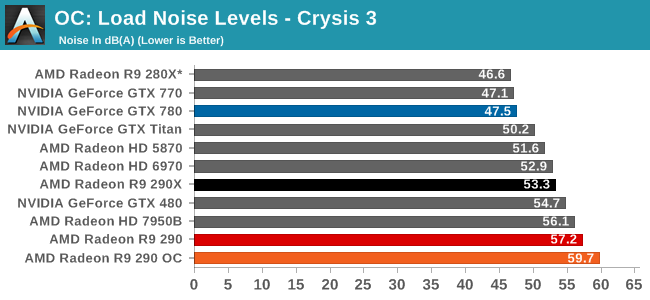
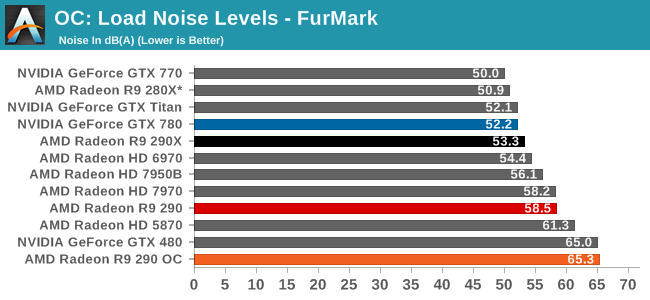
The 290 is already an unreasonably loud card at stock, and unfortunately the fan speed increases needed to handle the greater heat load from overclocking only make this worse. Under Crysis 3 we peaked at 59.7dB, or 49% fan speed. While under FurMark we peaked at 65.3dB, or 59% fan speed. For these noise levels to be bearable the 290 really needs to be fully isolated (e.g. in another room) or put under water, as otherwise 59.7dB sustained is immensely loud for a video card.
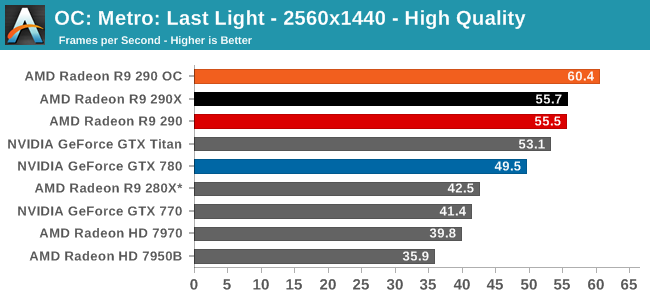
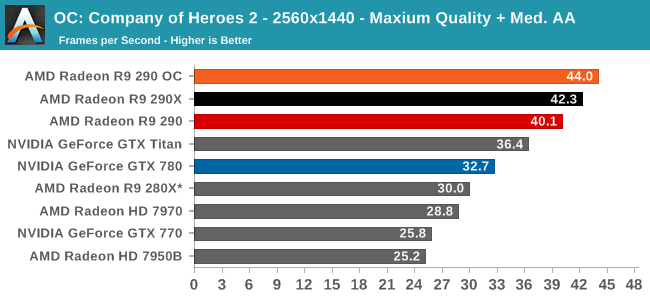
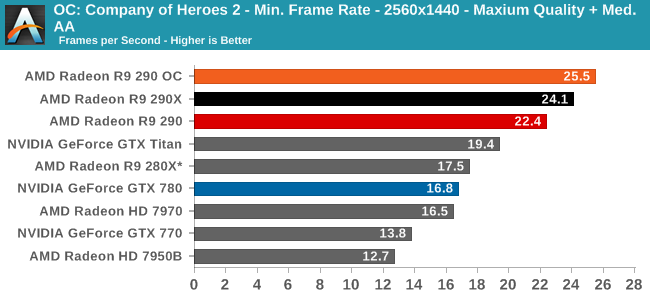
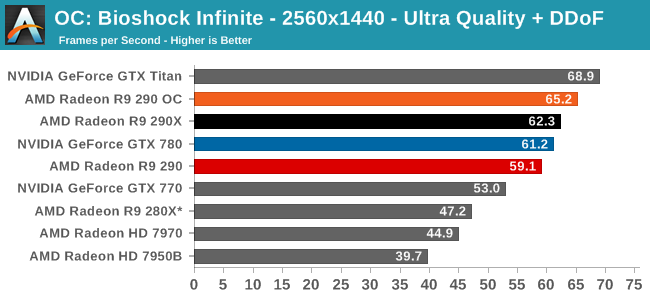
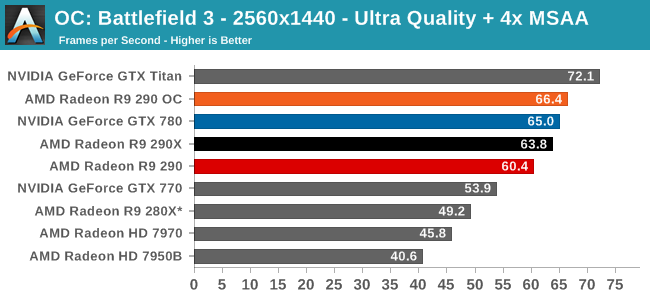
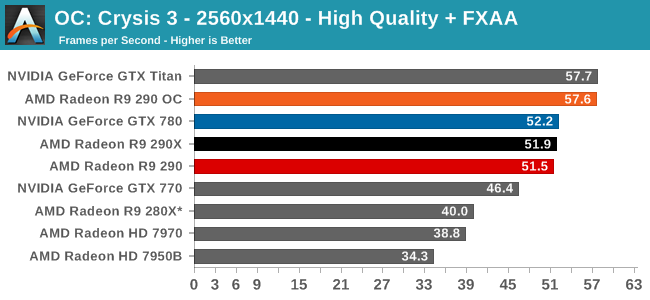
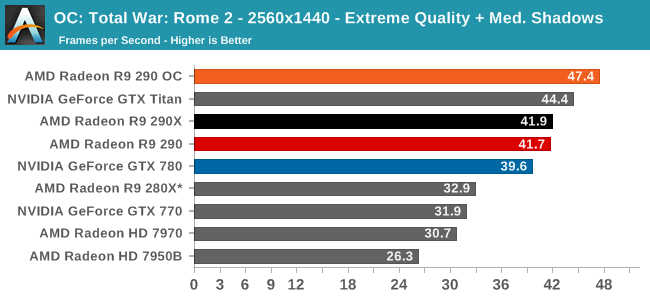
Finally getting to the matter of game performance, we’re seeing consistently strong scaling across every game in our collection. The specific performance increase depends on the game as always, but a 14% core overclock and 12% memory overclock has netted us anywhere between 9% in Metro up to the full 14% in Total War: Rome II. At this performance level the 290 OC exceeds the performance of any other single-GPU card at stock, and comes very close to delivering 60fps in every action game in our benchmark suite.










295 Comments
View All Comments
dragonsqrrl - Tuesday, November 5, 2013 - link
Fanboism? I know right?EJS1980 - Tuesday, November 5, 2013 - link
He was referring to you, and you know this.Mondozai - Friday, December 13, 2013 - link
EJS1980 the buttboy for Nvidia has spoken!JDG1980 - Tuesday, November 5, 2013 - link
Well, what the review fails to take into account is that for the vast majority of the card's lifetime, all or nearly all the cards actually sold will be using third-party coolers which are much better than AMD's halfhearted effort. All the noise measurements are completely irrelevant once Asus and MSI get their hands on the silicon and start releasing custom cards.A5 - Tuesday, November 5, 2013 - link
They can't review a card they don't have. I would think they will do a 290 round-up once some of the custom designs come out.Spunjji - Tuesday, November 5, 2013 - link
Quite right. This is a perfectly fair review.dragonsqrrl - Tuesday, November 5, 2013 - link
And then there's the disturbing revelation on Tom's that retail cards are underperforming AMD's reference review cards by a significant margin. But it's AMD, so it's okay.I mean seriously, could you imagine the uncontrollable outrage there would be if Nvidia tried to pull something like this? There would be an uproar from the community unlike anything the interweb's seen before. But if it's AMD? Largely silence, driven by either indifference (AMD fanboys), or AMD fanboy appeasement (confrontation averse reviewers). We wouldn't want to directly oppose the AMD fanboy agenda, lest we have to deal with yet another uproar from AMD's zealous fan-base, which occurs whenever a reviewer says anything remotely negative yet entirely relevant about an AMD product (Bulldozer, HD6990, R9 290, etc...)
just4U - Wednesday, November 6, 2013 - link
I've been watching this battle since the Radeon 8500 Geforce 3 days.. and to be absolutely honest with you.. don't matter what amd or Nvidia does fanboys will rage against the rival. It's the way they are... (shrug)Both companies have had their fair share of tricks btw.. (just in case you didn't know that or had forgotten)
dragonsqrrl - Thursday, November 7, 2013 - link
Uh, definitely haven't forgotten, otherwise there would be no context for the vastly different reactions I'm referring to. And honestly dude, I think you and other people who refer to the fanboy situation on both sides being the same are just displaying your own ignorance and unfamiliarity with the situation. I've noticed that despite how bad it can get here, I've never seen it get even remotely close to the norm on Tom's. It's gotten so bad at times (Bulldozer, HD6990, recent buyers guides, etc...) that the authors and reviewers have had to address the AMD fanboy situation directly in forums and comments. To which the zealous AMD fanbase becomes even more enraged, even resorting to malicious personal attacks against Chris, Don, etc, demanding to know why Nvidia/Intel fanboys are never addressed directly in the same way. Well, because they don't behave the same way... lol.When you genuinely believe that any author who doesn't conform to your inherently biased agenda is biased and bought out, and you adamantly defend that belief (over and over again) with childish and at times downright offensive remarks directed at both the authors and other readers, then it's not something that can be ignored. It never ceases to amaze me that despite how often they're thoroughly shutdown, and lose practically every argument they start, they still press on. They just ignore and continue. In fact if anything it seems to give them strength and further cement their delusional beliefs. They're an endless source of astonishment, those AMD fanboys, I'll give them that much.
Homeles - Tuesday, November 5, 2013 - link
From everything I've read, reference cards sell a lot more often than you'd think.